One’s a three-row midsize SUV under $60,000; the other’s a compact hatchback that starts in the mid-30s. Now we’ve driven both.
Choosing “best of” or “most important” new cars is always dicey, and doubly so with electric vehicles. New entries are announced virtually every month, and picking the 2025 models that will be most important throughout 2024 is risky for early January.
Still, the 2025 Kia EV9 and 2025 Volvo EX30 stand out as particularly important EVs for 2024. Each is the first entry into a particular segment, and both are very good cars. We’ve now driven both, and we can confirm that each should find eager buyers.
We fully expected to have one or two contenders from General Motors’ ambitious lineup of Ultium-based vehicles contending for the Most Important title. We’re not holding our breath for that mythical $30,000 Chevrolet Equinox EV, but we figured retail versions of Chevy’s Silverado EV pickup truck and Blazer EV SUV would have reached the market by now. They haven’t, and GM is clearly struggling to overcome a host of startup production problems with its Ultium vehicles—sales of which have remained far, far below the company’s own goals.
Kia EV9: the first mass-market 3-row electric SUV
Because it’s a mid-size SUV with three rows of seats, Kia’s next EV—and its largest to date—should be a familiar and appealing product for North American buyers. Despite high-end offerings like the Tesla Model X, Rivian R1S and Mercedes-Benz EQS SUV, no mass-market brand has brought a three-row SUV to the US market. (The Tesla Model Y’s sloping roofline severely limits space in its optional third row; those seats are unusable by most adults, even taller teens.)





That means Kia—not Ford, Chevy, Toyota, Nissan, or any other maker—will bring the first electric SUV under $60,000 to the US market with a third row usable by almost any passenger. Its sibling Hyundai will follow with its own version, the Ioniq 7, sometime during 2024. But the first Kia EV9s are starting to arrive at dealerships as you read this. Moreover, it won the 2024 North American Utility of the Year award this month, voted on by a panel of 50 automotive journalists from the U.S. and Canada chosen by their peers.
The first several months’ worth of EV9s will be built in South Korea, but US production will start sometime during 2024 in West Point, Georgia. That clears the first hurdle to qualify Kia’s electric three-row utility for the $7,500 federal purchase incentive (details on battery minerals and assembly are yet to be revealed). Waiting may save buyers money, though some will choose to avoid the earliest examples of a new model built in a new factory. As usual, high-end versions of the EV9 are likely to arrive before the least expensive versions.




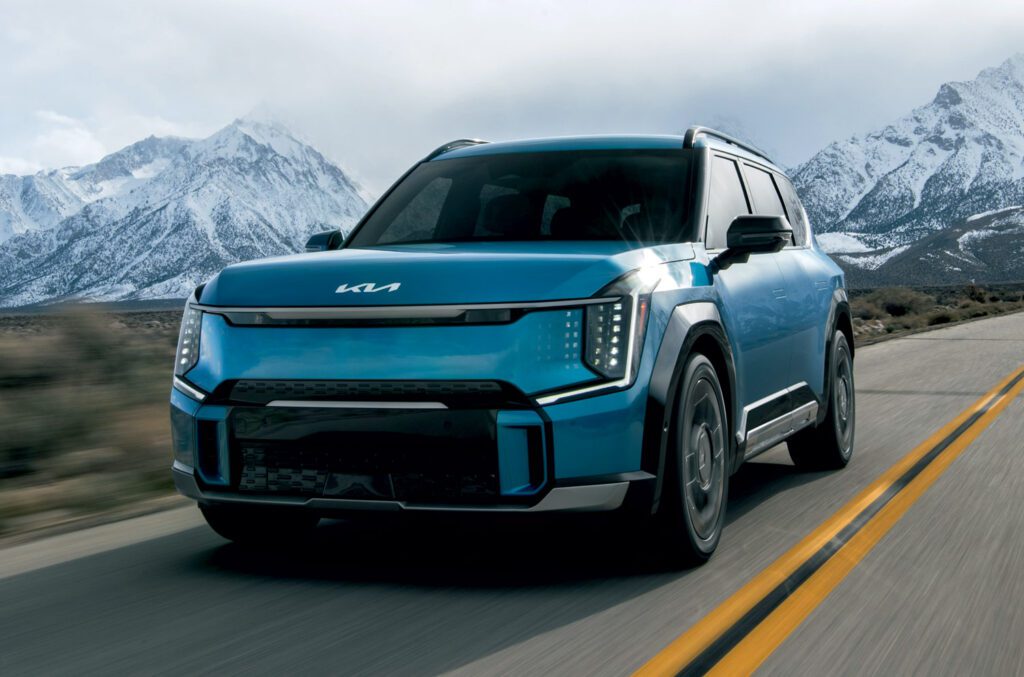

Blocky but wind-cheating
While it’s more aerodynamic than it looks, the EV9’s flat sides and blocky, square-cut lines fall into the heart of the current SUV market. Built on the company’s E-GMP platform—which already underpins two Hyundais, the Kia EV6 and the Genesis GV60—the big electric utility vehicle takes full advantage of the proportions allowed by EV hardware. Its blocky styling is still sleeker than most gasoline three-row SUVs, and it attracted looks both when parked and on the highway.
Overall, the EV9 is roughly the same size as Kia’s very popular Telluride three-row gasoline SUV. The two are less than an inch apart in length, width and height. But the electric EV9 has a wheelbase almost 9 inches longer, allowing room for a rear seat usable by real adults—not always the case in three-row midsize utes.
Priced at $56,395, the entry-level EV9 Light has a 76.1-kilowatt-hour battery powering a single 160-kilowatt (215-horsepower) motor. Its range is estimated at 230 miles; it’s the price leader that will lure buyers into the showroom. At $4,300 more, the larger 99.8 kWh battery option for the Light Long Range may be more popular; it’s estimated to provide 304 miles of range in rear-wheel-drive form, using a slightly less powerful 148 kW (201 hp) motor.
Mid-level trims (Wind, at $65,395, and Land, $6,000 more) come with dual motors delivering a total of 283 kW (379 hp) to power all four wheels, rated at 280 miles. The top trim GT-Line model, also with dual motors but a higher maximum torque rating, has an estimated range of 270 miles and starts at $75,395. All prices include a mandatory destination fee of $1,495.


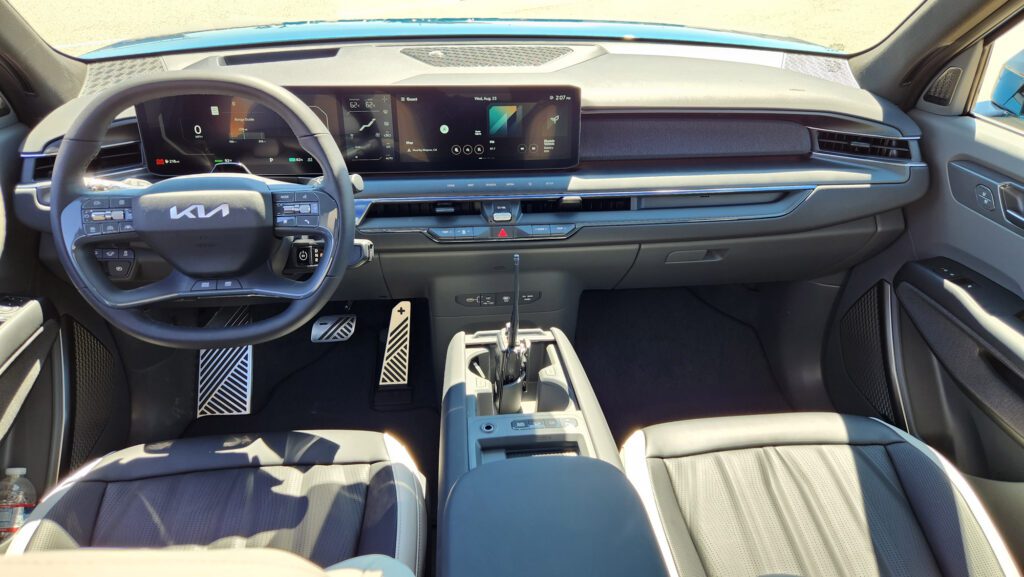

Impressive inside and out
A few hours spent driving two different pre-production EV9 models in August made it clear Kia has done its homework on this most American of EVs. A three-day loan in December simply confirmed the impression. The interior was packed full of useful storage pockets, cubbies, and shelves; the third row was adequately easy to enter and exit; and the ride, handling, and roadholding were exemplary—though it lacks the kick-you-in-the-back thrust a few of its smaller siblings offer. That’s probably fine for a family hauler. For a large electric SUV, it reported relative efficiency, with a total of 2.5 miles per kilowatt-hour over 290 miles that encompassed two-thirds highway speeds and one-third around-town use.
As always in Kia EVs, the “iPedal” mode for one-pedal driving has to be re-engaged not only with each on/off cycle, but even after switching into Reverse, then back to Drive. Learnable, but annoying when vehicles like the Chevy Bolt EV hold onto those settings through power cycles.
The cockpit design evolves on that seen in earlier Kia models. A pair of 12.3-inch screens is split by a 5.0-inch display, emphasizing the horizontal width of the cockpit. We got used to tapping to toggle between “+” for the home screen and “X” for on-screen ventilation controls. The twin-tier console floats between the two front seats, with a drawer beneath it accessible from the middle row.










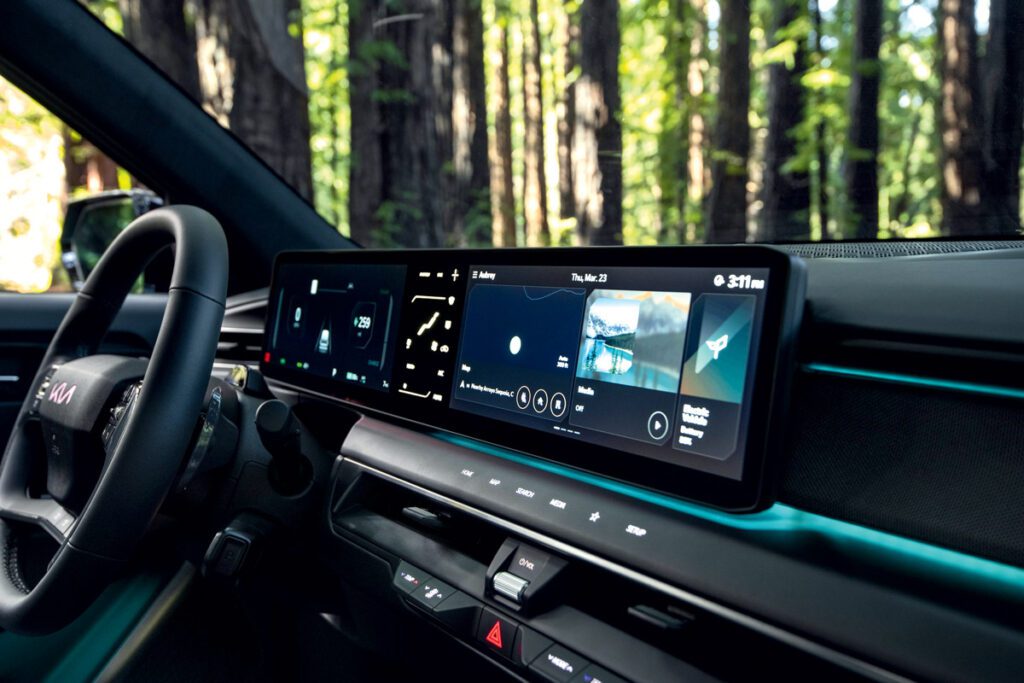

That second row comes either with a bench seat offering three positions, or reclining individual captains’ chairs. It’s truly capacious, handily accommodating our large 6’ friend Ben with room to spare. Taller occupants (though perhaps not Ben) will fit in the third row, though they’ll have to negotiate for legroom with second-row riders. Storage space is 20.2 cubic feet behind the third row, or 43.5 cu ft with the third row folded. Folding down both rows gives a whopping 81.9 cu ft.
Of all the mass-market brands sold in the U.S., Kia may have been the least likely to pioneer an EV in this core SUV segment. Unless, that is, you’ve been following Hyundai-Kia’s aggressive and ambitious approach to electric models across its range. Still, the top end of the EV9 range bumps up against the low end of the Rivian R1S lineup. Whether shoppers see the two brands as comparable is very much up for debate.
Volvo EX30: small and inexpensive, but is it premium?
At the other end of the scale from the large 3-row Kia EV9 is the Volvo EX30. It’s Volvo’s smallest-ever SUV, and also the fastest-accelerating car the company has sold. It’s a subcompact SUV designed first and foremost for Europe, where it’s a starter family car—sized well for tight city streets and alleys, or the winding one-and-a-half-lane roads that connect rural villages.
In North America, the EX30 is small enough that four full-size American adults will find it too tight for more than short trips. Instead, Volvo says, the little electric SUV might be the first new car for a young professional or a new couple, or empty-nesters who want to downsize their second or third vehicle now that they’re done hauling kids and their gear.


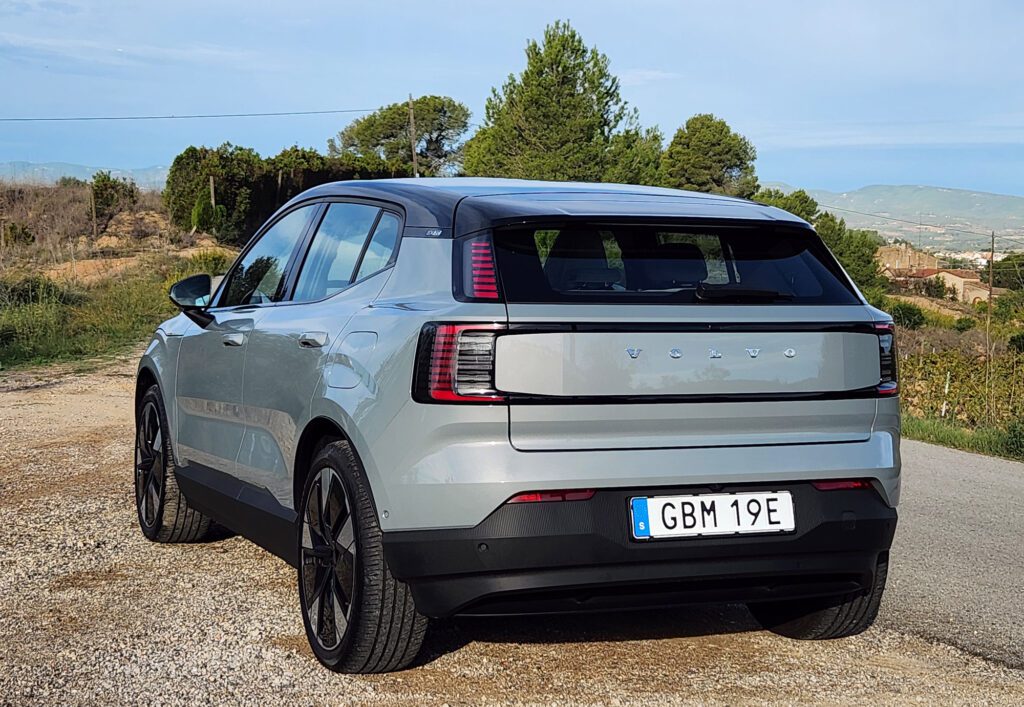

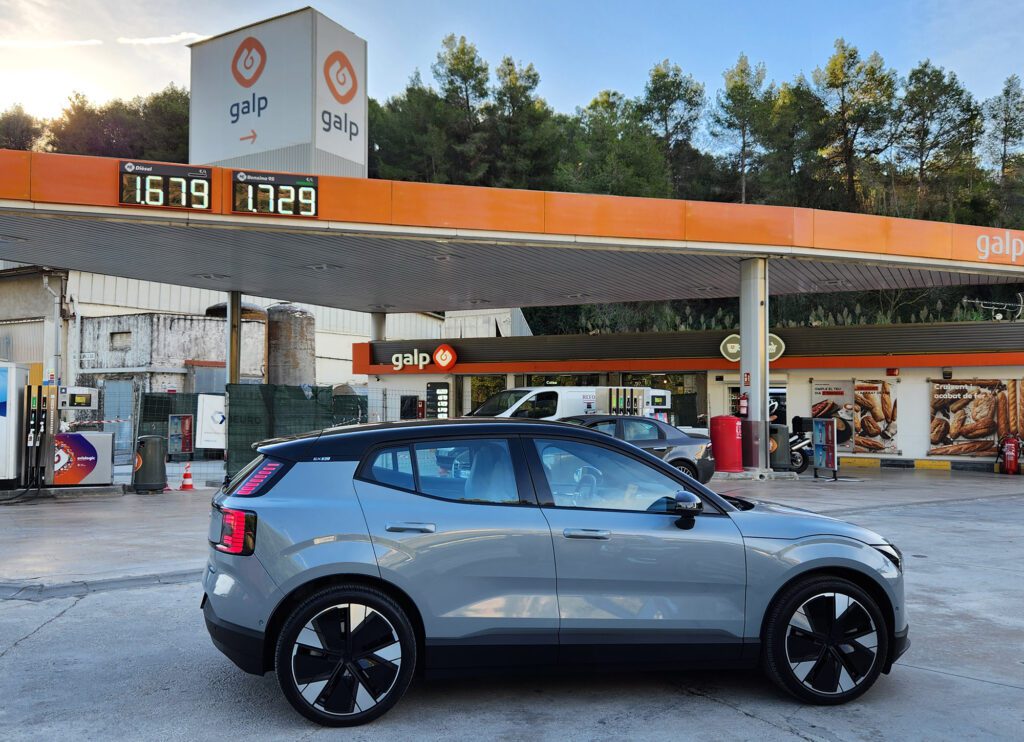





On the outside, it’s clearly a Volvo, from the upright SUV stance to the brand’s characteristic “ironmark” logo (better known as the male’symbol) on the plate where a grille would be. Like the larger XC40 Recharge, it’s relatively slab-sided and upright, and its 7.0-inch ground clearance and other characteristics define it as a light-duty truck (not a passenger car) under NHTSA rules.
Inside, car shoppers may stretch to view it as premium: a plethora of sustainable and recycled surfaces includes spotted hard plastics made of ground-up window frames, and other materials made from blue jeans, soda bottles and so forth. The starkness of the plastics is emphasized by a single 12.3-inch central touchscreen display through which all information arrives and almost all vehicle functions are controlled. It’s the closest thing yet to a Tesla Model Y presentation, and almost as simple to use, once you learn it. Thankfully, wipers have proper controls on the indicator stalk—unlike in Teslas—though a few other functions were more buried than we’d have liked.
Does this new EV live up to the Volvo premium brand? There’s no wood, and no leather. To be fair, the pale grey Pixel Knit woven textile feels like cloth, as does the deep blue Indigo fabric. But for customers used to the comfortable, clean Scandinavian modern interiors of higher-end Volvos, with pale woods and available leather, some of the sustainable plastics may prove jarring.
From quick enough to rocket
On the road, however, the EX30 excels. The single-motor, rear-wheel-drive version was quick enough for any urban or highway situation we encountered during test drives of pre-production versions that spanned seven hours over two October days in and around Barcelona, Spain.
The twin-motor version felt somewhat faster as standard, but dropping it into Performance mode (an inconspicuous tap button buried in a vehicle menu on the center screen) turned it into a rocket. Volvo quotes 3.4 seconds for 0-60 mph acceleration, and we believe it. While the acceleration isn’t quite as abrupt and kick-you-in-the-kidneys fast as top-end Teslas can get, it’s entertaining and addictive. Thankfully the friction brakes are suitably beefy to haul it back just as fast.
The EX30s we drove were quiet under any circumstance we encountered, with no audible motor or electronics whine and very little wind noise. They held the road well and felt confident and capable cornering on the switchbacks and narrow winding roads in the hills outside Barcelona.
Our main complaint about the driving experience was the EX30’s exceptionally light regenerative braking—whose alternative is no regen at all. It felt closer to that of a hybrid with a 1.5 kWh battery than an EV with a battery 50 times that size. Even the development team seemed split on whether they should offer an option for stronger regen, which seemingly a number of reporters and reviewers had suggested.






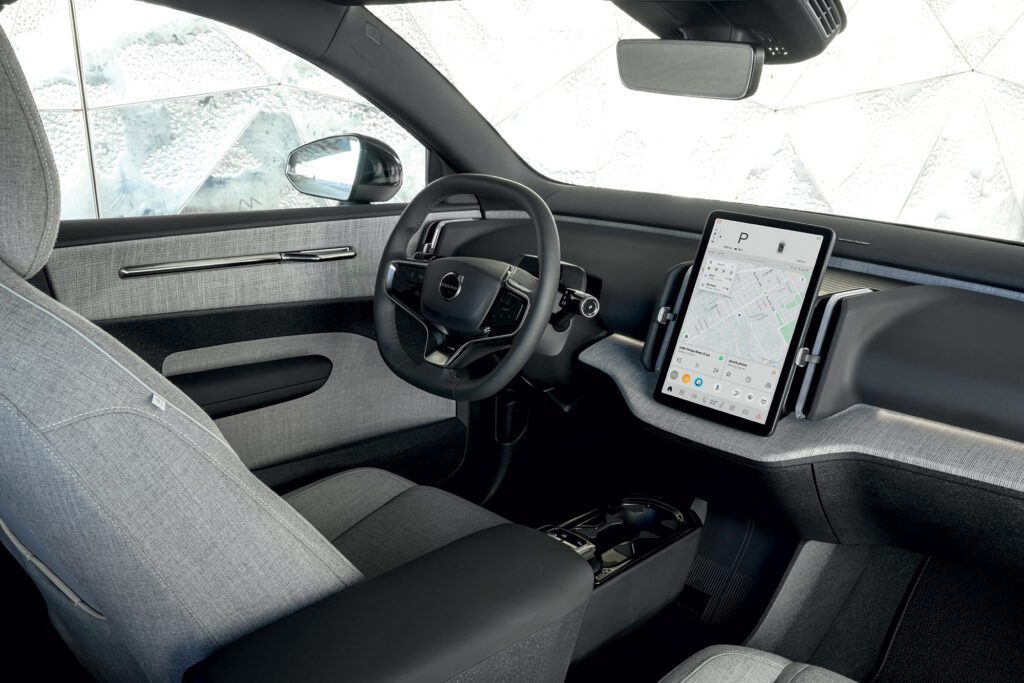



Keeping it light prevents drivers new to EVs from being startled by the experience of strong regenerative braking, said one powertrain engineer. But the product chief acknowledged that the issue isn’t settled, and that experienced EV drivers clearly preferred a stronger regenerative function. Consider this one a work in progress.
Sustainability a key
Volvo is now hitting the sustainability message hard. It already benefits from a well-known and well-respected brand with an impeccable safety reputation. Now, add sustainability to the safety: It says it will sell only battery-electric vehicles from 2030, and the entire company will be carbon-neutral by 2040.
The EX30 will be a big part of that. It should do well in European markets that know the brand, buy lots of B-segment cars (also more and more utility vehicles), and now eagerly opt for electric powertrains.
Volvo claims the EX30 is the most sustainable vehicle it’s built to date. Part of that is its small size (meaning fewer materials overall), along with recycled materials, the relative efficiency of an EV powertrain in a smaller vehicle, and sustainable power for the factory where it’s built.
That factory is in Zhangjiakou, China. The EX30 was the first high-volume Volvo planned to be built only in China, for export to all global markets. In October, though, Volvo announced that, due to positive public reaction and high demand, it would add production of the EX30 to its factory in Ghent, Belgium, where the current XC40 Recharge and C40 EVs are built. Expect US EX30s to come from Europe, once that line is up and running, to avoid import tariffs on China-built vehicles.
Chinese assembly and sourcing is likely one of the reasons the EX30 can carry a starting price of just $36,245 (including a mandatory delivery fee of $1,295). That’s almost $12,000 lower than the sales-weighted average transaction price of all new US auto models. A top-end, dual-motor EX30 is still priced below $50,000.
Expanding Volvo’s audience
“We’ve gotten an amazing reception, with way more pre-orders and hand-raisers than we expected,” said Mike Cottone, CEO of Volvo Cars in North America. “And it will add new consumers to the brand—80 percent of those people are new to Volvo.”
Volvo execs in Barcelona firmly declined to specify US sales targets, but said they expected the EX30 to become “one of our higher volume models.” Indeed, in today’s US market, an entry-level, all-electric Volvo SUV with 265 or 275 miles of EPA-rated battery range, starting under $40,000, is a compelling proposition.
Moreover, the EX30 has zero direct competition in North America. The closest EVs to its size, the Chevrolet Bolt EV and EUV, are to go out of production in November 2023—and Chevy is hardly the premium brand that Volvo is. Nor are Hyundai or Kia, which offer the Kona Electric and Niro EV, respectively. But, like the Bolt pair, neither of those cars offers all-wheel drive as the EX30 does.
Order books were originally scheduled to open in November, but Volvo has delayed that to the early part of this year—with first customer deliveries in the U.S. and Canada now scheduled to start sometime this summer.
For now, if you want a small EV from a premium brand, the EX30 is your only option. Audi, BMW, Genesis, Lexus and Mercedes-Benz only offer electric SUVs in larger and much pricier segments. For that reason, the EX30 stands alone—and that makes it an important, and affordable, EV for this year.
Kia and Volvo provided airfare, lodging, and meals to enable Charged to bring you this first-person report. The author of this article is one of 50 jurors from the automotive media who vote on the annual North American Car, Truck, and Utilty of the Year awards.



